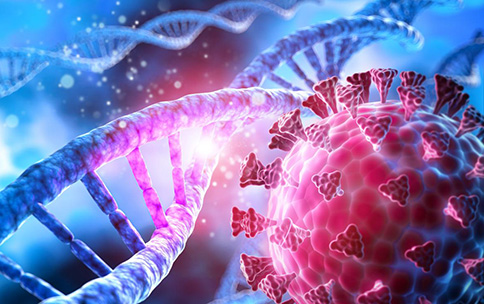
Although our understanding of COVID-19 has advanced dramatically since the start of the pandemic, there is a lot we don’t know about how cellular processes change after SARS-CoV-2 infection. A new study led by Common Fund 4D Nucleome (4DN) program researcher Wenbo Li, Ph.D. shows how SARS-CoV-2 can rewire how DNA is structured within human cells in a way that may be linked to weakened immune responses.
SARS-CoV-2 infection can delay or weaken the body’s first immune responses, which can lead to a more serious viral infection. The virus can also cause increases in cytokines, signaling molecules that cause damaging inflammation. These and other immune responses are controlled by genetic activity, which is regulated in part by the three-dimensional organization of DNA in the nuclei of our cells. DNA folds into a structure called chromatin, and genes can be turned on or off depending on the structure of chromatin and the proteins attached to chromatin fibers.
In the new study, Dr. Li and his research team found that SARS-CoV-2 infection caused significant changes to chromatin organization in human cells. The team used advanced sequencing techniques developed as part of the 4DN program to study how chromatin behaves in human cells with or without SARS-CoV-2 infection. Areas of chromatin that are close together in healthy cells were found to be further apart after SARS-CoV-2 exposure, indicating that SARS-CoV-2 could be responsible for changing genetic activity because of the changes to chromatin structure. Regions of chromatin that no longer interacted with each other were also free to interact with other regions much farther away in the genome, further disrupting the control of normal genetic activity.
This same study found that the weakened immune response experienced in some cases of COVID-19 could be linked to how SARS-CoV-2 interacts with the genome. Chromatin is wrapped around proteins called histones that can be modified to activate or suppress genetic activity close by. After SARS-CoV-2 infection, chromatin in areas of the genome involved in immunity had fewer histone modifications that activate genes, which could contribute to a weaker immune response and ability to fight infection. Infected cells had higher levels of histone modifications that stimulate inflammation and cytokine production, which follows the trends seen in cases of COVID-19 with increased inflammatory cytokine levels. Because these changes were specific to SARS-CoV-2 and not another type of coronavirus, the new understanding of the genetic processes behind these effects may provide new strategies to treat SARS-CoV-2 infection early on. The work of the 4DN program to investigate how chromatin organization changes after infection by viruses like SARS-CoV-2 may also help understand the long-term effects of COVID-19 or find new ways of fighting other diseases.
Reference
- SARS-CoV-2 restructures host chromatin architecture. Wang R, Lee JH, Kim J, Xiong F, Hasani LA, Shi Y, Simpson EN, Zhu X, Chen YT, Shivshankar P, Krakowiak J, Wang Y, Gilbert DM, Yuan X, Eltzschig HK, Li W. Nat Microbiol, 2023 Apr;8(4):679-694. doi: 10.1038/s41564-023-01344-8.


